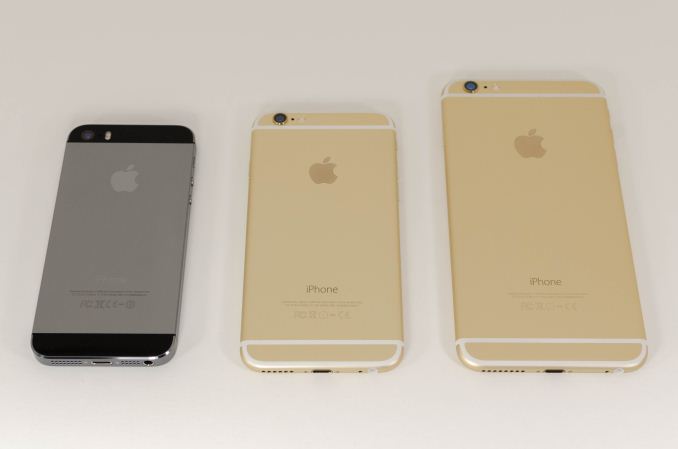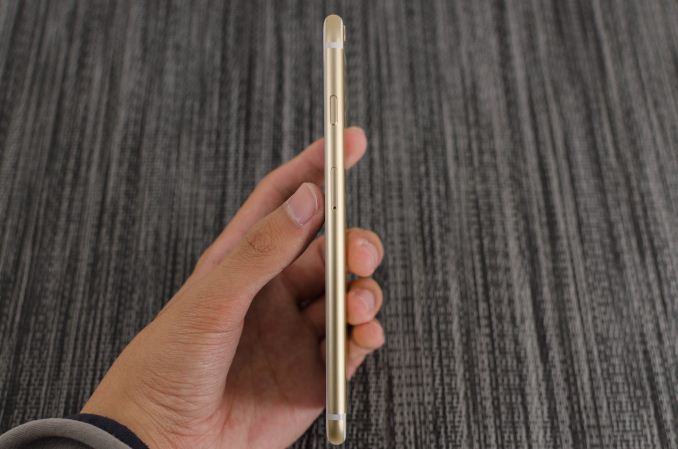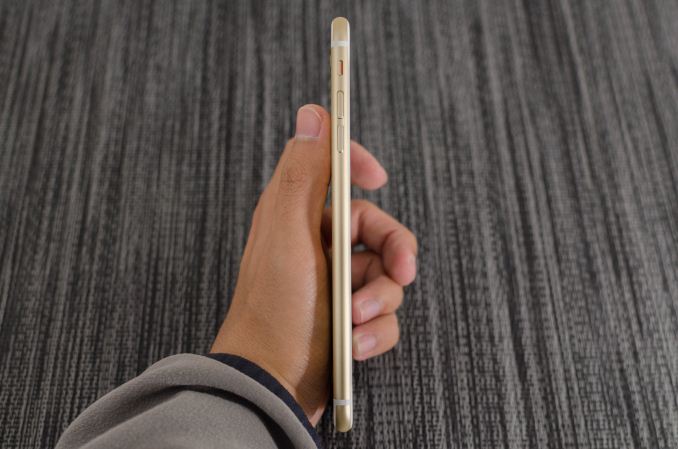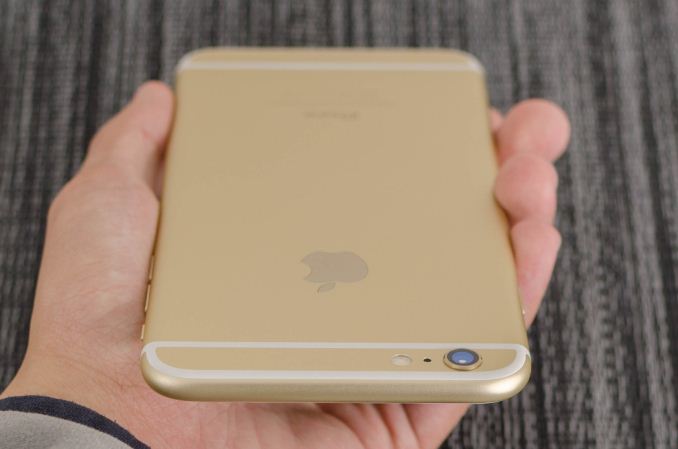The iPhone 6 Plus Mini-Review: Apple's First Phablet
by Joshua Ho on September 30, 2014 8:00 AM EST- Posted in
- Smartphones
- Apple
- Mobile
- iOS
- iPhone 6 Plus

While we’ve also written about the iPhone 6, the iPhone 6 Plus needs its own review in order to really understand the various features of the device that would otherwise be buried in the context of the iPhone 6. Without question, this device represents a significant departure from the way Apple has competed in the smartphone space. Until now, Apple hasn't competed in the phablet space and has thus avoided competing with Galaxy Note line that has been established as the dominant phablet for the past 3-4 generations. As a result, Apple occupies a fast-follower position at best.
This brings us to the iPhone 6 Plus, which really is an extension of the iPhone 6. Both phones share the same SoC, NAND configurations, front and rear camera sensors, LED flash module, industrial/material design, TouchID home button, earpiece and speaker configuration, WiFi/BT chipset, modem, and button layout. At this point, I’m going to stop listing similarities because the iPhone 6 Plus is interesting for its differences. Unlike similarities, the differences are simple. The iPhone 6 Plus is bigger, the display has higher pixel density, the camera has optical image stabilization, and iOS 8 has new app designs to take advantage of the larger screen. The iPhone 6 Plus is also more expensive, with the 16GB version starting at the same price as the 64GB version of the iPhone 6.
While I’ve already discussed the design of the iPhone 6, it’s important to see whether the same design translates to the iPhone 6 Plus. To this end, the iPhone 6 Plus does well. While the angular design of the iPhone 5 line would have looked and felt enormous in the hand, the shape is quite similar to the iPad line and is similarly comfortable in the hand, although the rounded edge really differentiates it, as does the control scheme. The only real issue here is that the top bezel on the front becomes surprisingly large, and this seems to contribute to a sense that the phone is top-heavy even though the phone is evenly balanced.
| Apple iPhone 5s | Apple iPhone 6 | Apple iPhone 6 Plus | |
| SoC | Apple A7 | Apple A8 | Apple A8 |
| Display | 4-inch 1136 x 640 LCD | 4.7-inch 1334 x 750 LCD | 5.5-inch 1920 x 1080 LCD |
| WiFi | 2.4/5GHz 802.11a/b/g/n, BT 4.0 | 2.4/5GHz 802.11a/b/g/n/ac, single stream, BT 4.0, NFC | |
| Storage | 16GB/32GB/64GB | 16GB/64GB/128GB | 16GB/64GB/128GB |
| I/O | Lightning connector, 3.5mm headset | ||
| Size / Mass |
123.8 x 58.6 x 7.6 mm, 112 grams |
138.1 x 67 x 6.9 mm, 129 grams |
158.1 x 77.8 x 7.1 mm, 172 grams |
| Camera |
8MP iSight with 1.5µm pixels Rear Facing + True Tone Flash 1.2MP f/2.4 Front Facing |
8MP iSight with 1.5µm pixels Rear Facing + True Tone Flash 1.2MP f/2.2 Front Facing |
8MP iSight with 1.5µm pixels Rear Facing + True Tone Flash + OIS 1.2MP f/2.2 Front Facing |
| Price |
$99 (16GB), $149 (32GB) on 2 year contract |
$199 (16GB), $299 (64GB), $399 (128GB) on 2 year contract |
$299 (16GB), $399 (64GB), $499 (128GB) on 2 year contract |
Overall, even though the iPhone 6 Plus is noticeably taller than the Galaxy Note 3 both feel similar in size. The iPhone 6 Plus is on the thinner side which makes a significant impression in the hand. At any rate, it’s physically impossible for me to use this device with one hand for most situations. It’s definitely a tablet in this sense, but in a much more compact and pocketable form factor.
"Bendgate"
Of course, drawing the comparison between the iPhone 6 Plus and Galaxy Note 3 inevitably raises the question of “bendgate”, which draws interesting parallels with “scuffgate” from the iPhone 5 generation. Unfortunately, I can’t destroy multiple review units in order to thoroughly investigate this issue. However, we can look at Consumer Reports’ data and come to a few conclusions about this problem. The first is that in the case of the iPhone 6 Plus, there appears to be an area near the bottom of the volume buttons that is a weak point as we see a clear failure of the casing in this area.
However, it seems that there is a significant amount of force needed in the first place in order to cause permanent deformation. Otherwise, everything that we’ve seen is primarily the result of fundamental differences between the two materials. It’s clear that in the case of the Galaxy Note 3 that a great deal of the structural rigidity is tied to the display itself, so the case doesn’t quite provide much in the way of protection as the polymer used is clearly in the elastic region all the way to failure. LG seems to have a different design though, as their polymer material has a clear case of brittle failure at the limit, which saved the display from shattering.
It's certainly possible to bend the iPhone 6 Plus (or really any phone or tablet), but the real issue here that hasn’t been addressed is the level of force needed to cause a certain level of elastic or plastic deformation in the material. This matters far more when discussing drop protection as the level of force in such a scenario is relatively small but applied over an extremely short period of time. There’s also no mention of force per unit area in any of these figures, so we can’t really have a serious discussion about this issue without the necessary data.














191 Comments
View All Comments
MacrosTheBlack - Tuesday, September 30, 2014 - link
Yet apple's A series "dual core" processors typically outperform the latest quad core flavor of the week and do it at a lower clock rate. Derp. Go back to your cave now.Alexey291 - Tuesday, September 30, 2014 - link
yeeeeeeeah usually in a single over-optimised benchmark aka sunspider :DAaaaaand nothing much else.
bigstrudel - Wednesday, October 1, 2014 - link
And Octane, Browsermark, Kraken, Peacekeeper, WebXPRT...and Sunspider. And that's just the web benchmarks.nerd1 - Wednesday, October 1, 2014 - link
Browser performance is single threaded testing and obviously favors higher-clocked low-core APs (or apple devices). Also don't forget that anandtech is always using chrome browser for testing android browser performace, which is almost twice slower than samsung's stock browsers - and they are using highly optimized Safari for testing apples. Totally not fair.akdj - Thursday, October 2, 2014 - link
Samsung's 'stock' browser? FAST? You've GOT to be kidding me. I've got the Note 3 and at least a dozen browsers. Samsung's is by FAR & AWAY the slowest turtle of them all. Why continue spewing? Did you not read any of the article? The review on the '6'? This A8 is top of the heap. Browsers. Computationally. Graphically. While not always number one, it's in the top two or three in every bench performed including GB3/Kraken/Octane. Not to mention the display accuracy, battery efficiency and ...well, yeah. Totally. Fair.beaker7 - Tuesday, September 30, 2014 - link
Feel better?melgross - Tuesday, September 30, 2014 - link
Wasting our time again, I see.bitNine - Tuesday, September 30, 2014 - link
Have you ever watched someone do a really terrible job at something, then turned around and learned from those mistakes and built something better? That's what Apple is doing. It's actually quite genius. They watch Samsung, HTC and LG fail in certain areas as they pump out the next pointless device which a few thousand people will buy, just to struggle to compete. Meanwhile, using an OS which is fragmented to its core, and reminiscent of Windows Mobile <=6.5. Google makes it, HTC modifies it and ruins it (just like they always did with windows mobile), and unfortunately community roms aren't much better because they lack QA. Buggy, susceptible to malware, but wide open and capable of doing more.As for copying and saying Apple has no innovation, what's with Samsung suddenly copying the fingerprint reader in the home button? What about the fact that Apple is first to have 64bit architecture? All the rest are eons behind, and STILL haven't released any devices with 64bit. It's no longer 2005. They all copy each other in order to compete, and that's what makes ALL DEVICES better. The sooner you get that through your head, and past those ugly blinders you're wearing, the better.
When you directly compare Samsung flagship phones to Apple phones, they constantly one-up each other. You'd know that if you actually paid attention to the raw tests done here at Anandtech. The S5 beat the iPhone 5S and the iPhone 6 destroys the S5 (except in physics category). It's a leap-frog game, and one you clearly can't see because of those aforementioned blinders.
Over-expensive? All other device types aside, when you compare prices with Samsung, LG and HTC, Apple is quite competitive. Not quite so in the tablet market, but phones are competitive. They are all $199 with a contract, and most of them start in the $650 range for full price.
Why is it you believe everyone needs more than 16GB. There are plenty of people out there who wouldn't care about more space. Apple caters to those people and provides a $100 cheaper phone for that reason. They know the market, and you obviously don't.
As for pixel density, who gives a crap which has a higher pixel density considering that 100% of people can't see the individual pixels anyway. I've got 20/15 vision and have never had a complaint about any retina screen being too low resolution. That's just a specs game that iHaters are quick to exploit, and it's something that makes it clear that you don't actually know what you're talking about when it really comes down to it. The only thing you actually got right about the screen is the superiority of OLED over standard LCD (even IPS). Any idea what a larger, and unnecessary, resolution does for the phone? It uses more power, which equals less battery life. Especially when you're talking about a backlit screen. There is simply no need to have a higher resolution screen when it's unnecessary. Pushing for a higher resolution and convincing consumers that it's so necessary, is just as stupid as attaching a marketing term like retina display. They are the same thing, but your brlinders don't allow you to see it. I mean, "Super AMOLED" is a Samsung marketing term. There's not even a reason to have the AM because OLED is, by default, Active Matrix. Yet for some reason, you don't realize this because of your blinders. Don't forget that OLED screens tent to deteriorate faster than an LCD, meaning that iPhone displays will outlast Samsung's. And nevermind that Samsung makes over 90% of OLED phone displays in existence today, and they can barely keep up with their own demand for screens. Adding another several million displays doesn't help that matter. The supply and manufacturing chain must be developed first.
Now, let's take a look at the differences between Samsung's flashy new phone, the Galaxy Note 4. OMG, a fingerprint reader! That's it, aside from a processor upgrade. There's nothing else to the phone aside from the basic updates. It's like the update from the iPhone 5 to the 5S. But you'd never in a million years admit that it's EXACTLY THE SAME THING APPLE DOES, because of, again, the blinders.
I am not dissing Android or Android phones, because Android is an awesome OS with its own faults just like iOS and WP. They are all the same. There is nothing special about what Samsung, HTC and LG do. Just like there's really nothing special about what Apple does. Unfortunately, you're so one-sided that your blinders don't allow you to see that they are all the same, and that the competion between them is exactly what we need and want. Apple gives you better Android phones, and Android phones give iPhone users better iPhones. They are all innovative, and they all have awesome ideas that are better than the other side of the fence.
As I always say, anyone who says one platform is clearly better than the other (other than saying it's better specifically, and only, for themselves), doesn't know wtf they're talking about. You're one of "those people".
nerd1 - Wednesday, October 1, 2014 - link
What a load of BS. Apple is milking customers by not providing memory expansion option (64GB microSD now costs as little as $30, and it will be even cheaper!), and NEVER ever lowers the prices of their device for a whole year. All other OEMs offer cheaper devices from the start, even cheaper with memory expansion, and that gets even more cheaper as time goes by.And apple has the worst hardware - iPhone 6 has worse display than $300 phones, and 1GB of ram is just downright laughable in 2014. Oh there IS passive matrix OLED by the way.
Compare two keynotes from samsung and apple. Sammy showed WQHD OLED, new pen with 2048 levels of sensitivity and tilt sensing, new larger and higher resolution front and back cameras, curved screen, and finally portable VR device presented by god damn John Carmack himself.
Was that ANYTHING new with the apple keynote? Absolutely nothing. And their iPhone 6 plus offers basically nothing new over standard phone (sammy has active pen and multi-screen multitasking for example)
akdj - Thursday, October 2, 2014 - link
You'd do yourself a favor reading bitNine's response to you. Or learning before speaking. Apple released a new CODE! (Swift), a low level code and OpenGL ES overhead elimator (Metal), integrated iOS and OS X with Handoff and Continuity and contrary to your ridiculous OLED fantasies and ignorance about iphone 6's display (or the actual review itself, did you read it?), it's the Best in the Business Bud!I love my Note. Love my iPhone. Dig my iPad and enjoy my HP 2in1. Don't be a DBag and preach from one side of the fence. Jump it and open your mind.
You sound ridiculous (or 13).